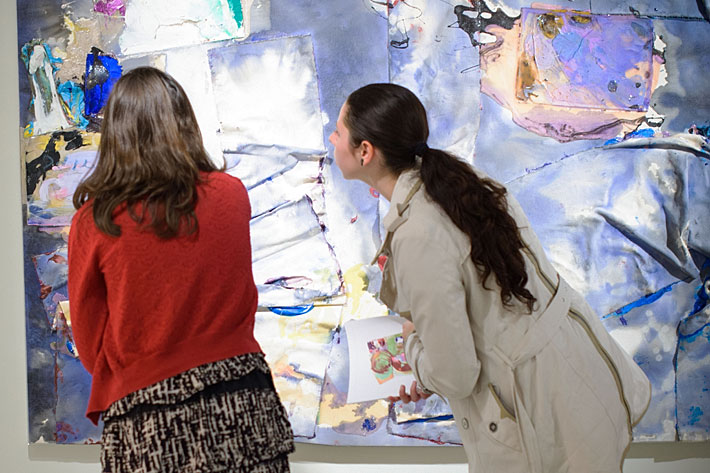In 1980, an exasperated Susan Roth threw down pieces of a canvas that she was collaging into painting, leaving the strips abandoned on her studio floor. When she returned later, she inspected the trashed piece with new eyes. The piles had new dimension and the layers simultaneously hid and revealed surfaces, clumps forcing shape to be organic and less architectonic, suggesting potentials for a powerfully expressive form. This represented an aesthetic that would guide her work since.
The 21 paintings featured in the Luther W. Brady Art Gallery’s newest exhibition, “Form, Frame, Fold,” embrace the blend of vibrancy and structure that Ms. Roth unlocked during that paroxysm in 1980. Since then, the artist has introduced steel into her work, adding an industrial quality that critics have referred to as “Susan Roth’s Toughness.”
“Ms. Roth structures her colors and forms in such a way that they float and tend to shift in configuration and depth right before our eyes,” said Brady Art Gallery Director Lenore Miller. “The paintings are weighty, both physically and psychologically.”
“Form, Frame, Fold” marks Ms. Roth’s first solo show in 24 years. The exhibition has received a positive response throughout campus—two undergraduate classes from the university’s fine arts and art history programs and a graduate art history class toured the show, as did children from GW’s on-campus childcare center.
At the opening reception on Oct. 22, Luther W. Brady, who endowed the Brady Art Gallery in 2002, recalled his first encounter with Ms. Roth’s work years ago. Dr. Brady was struck by the “unique and unusual” qualities of her paintings and suggested presenting them in Washington, D.C., for the first time. Speaking from a welding studio in Maine, Ms. Roth discussed the resulting exhibition with George Washington Today assistant editor Julyssa Lopez.
Q: A turning point in your work came when you returned to your studio and examined a painting that you had abandoned. What did you see in that moment of rediscovery?
A: Our unconscious or subconscious sees and does things, if we allow it. Sometimes, we can’t help ourselves. Things happen. That’s how I feel about that moment. I was working so hard, and I wanted something more from my work so badly. I was looking for a way to express myself that was ultimately personal, but also universal. It seemed that I couldn’t make art as good as the art that I dreamed of. I left the studio that day in a particular kind of a flurry.
In that moment of going back, I was shocked because I saw what I was looking for—I had stumbled upon it. I don’t think it’s unusual. I think you can hear these stories over and over again from scientists and musicians, of things they write on a napkin or the storm that they’re chasing in their heads.
Q: Ms. Miller named the exhibition, “Form, Frame, Fold.” How does the name relate to the relationships with paint and structure in your work?
A: The name engenders all the broad things every artist thinks about. It’s allowed me a lot of ways to talk about my work. By talking about these three words, I think that’s where content starts to rise, and where people start to understand it.
Q: You’re currently working out of a welding studio in Maine. What was your experience discovering steel? How has the material informed your work?
A: I was given the opportunity to work in the studio here. At first, I tried a couple of times, but it was more of the constructivist steel sculptures—post-David Smith and post-Anthony Caro—and I wasn’t that interested for myself. A friend kept asking me if I was going back to the studio, and although I said no, I felt like I was letting him down. So I put my shoes on, and it was very much like what happened with my paintings. I shrugged my shoulders and said, “I’ll pretend I’m painting.” I started laying things out the way I do in the painting studio, and I fell in love. I found I had a lot of things to say that were interesting, personal and curious to me.
Q: This is your first solo exhibition in 24 years. Can you describe your working process in that span of time?
A: I’m always working, and I’ve always been working. When the show opened, so many people came from so many different places. It was really a kind of homecoming for me, and a particularly special one.
I left New York in 1990 and made a series of decisions that would have lasting repercussions. I recognize from that experience that I’m not the sort of artist who shows annually. I came onto the scene where artists showed once a year. It’s arbitrary. When you look at how many times Cézanne had a show in his lifetime, you kind of scratch your head and recognize that this isn’t really about the art, it’s about economics. For me personally, it’s been good for the art, and it has allowed me to experiment.
Q: What messages can aspiring artists find in “Form, Frame, Fold?”
A: My work is made from many different things. It’s the opposite of moving in the direction of minimalism, one-color pictures or a kind of personal singularity. My work is made of many disparate parts, whether it’s canvas or steel. The idea is to make them one object. If there’s anything that I hope people see, it’s that art can be made out of anything, in any time, in any place.


